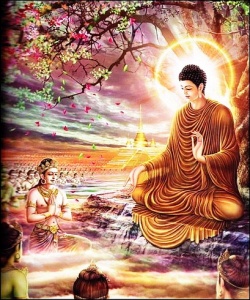Difference between revisions of "Thirteen Buddhas"
| Line 1: | Line 1: | ||
[[File:Preaching.JPG|thumb|250px|]] | [[File:Preaching.JPG|thumb|250px|]] | ||
| + | |||
| + | |||
| + | |||
| + | |||
| Line 7: | Line 11: | ||
The [[Thirteen Buddhas]] ([[十三仏]] [[Jūsanbutsu]]?) is a {{Wiki|Japanese}} grouping of [[Buddhist]] [[deities]], particularly in the [[Shingon]] [[sect]] of [[Buddhism]]. The [[deities]] are, in fact, not only [[Buddhas]], but include [[bodhisattvas]] and [[Wisdom]] [[Kings]]. In [[Shingon]] services, lay followers recite a devotional [[mantra]] to each figure, though in [[Shingon]] practice, | The [[Thirteen Buddhas]] ([[十三仏]] [[Jūsanbutsu]]?) is a {{Wiki|Japanese}} grouping of [[Buddhist]] [[deities]], particularly in the [[Shingon]] [[sect]] of [[Buddhism]]. The [[deities]] are, in fact, not only [[Buddhas]], but include [[bodhisattvas]] and [[Wisdom]] [[Kings]]. In [[Shingon]] services, lay followers recite a devotional [[mantra]] to each figure, though in [[Shingon]] practice, | ||
| + | |||
| + | |||
[[disciples]] will typically devote themselves to only one, depending on what the [[teacher]] assigns. [[Thus]] the [[Chanting]] of the [[mantras]] of the Thirteen [[Buddhas]] are merely the basic practice of [[laypeople]]. | [[disciples]] will typically devote themselves to only one, depending on what the [[teacher]] assigns. [[Thus]] the [[Chanting]] of the [[mantras]] of the Thirteen [[Buddhas]] are merely the basic practice of [[laypeople]]. | ||
| + | |||
| + | |||
The Thirteen [[Buddhas]] are also an important part of a [[traditional]] {{Wiki|Japanese}} [[Buddhist]] [[funeral]] service, with each [[deity]] having a [[corresponding]] memorial service for the deceased. The thirteen in {{Wiki|Japanese}} and [[Sanskrit]] and the [[corresponding]] date of their service after the [[Death]] are: | The Thirteen [[Buddhas]] are also an important part of a [[traditional]] {{Wiki|Japanese}} [[Buddhist]] [[funeral]] service, with each [[deity]] having a [[corresponding]] memorial service for the deceased. The thirteen in {{Wiki|Japanese}} and [[Sanskrit]] and the [[corresponding]] date of their service after the [[Death]] are: | ||
| + | |||
#[[Fudo]] ([[Acala]]), 7th day | #[[Fudo]] ([[Acala]]), 7th day | ||
| + | |||
#[[Shaka]] ([[Sakyamuni]]), 14th day | #[[Shaka]] ([[Sakyamuni]]), 14th day | ||
| + | |||
#[[Monju]] ([[Manjushri]]), 21st day | #[[Monju]] ([[Manjushri]]), 21st day | ||
| + | |||
#[[Fugen]] ([[Samantabhadra]]), 28th day | #[[Fugen]] ([[Samantabhadra]]), 28th day | ||
| + | |||
#[[Jizo]] ([[Ksitigarbha]]), 35th day | #[[Jizo]] ([[Ksitigarbha]]), 35th day | ||
| + | |||
#[[Miroku]] ([[Maitreya]]), 42nd day | #[[Miroku]] ([[Maitreya]]), 42nd day | ||
| + | |||
#[[Yakushi]] ([[Bhaisajyaguru]]), 49th day | #[[Yakushi]] ([[Bhaisajyaguru]]), 49th day | ||
| + | |||
#[[Kannon]] ([[Avalokitesvara]]), 100th day | #[[Kannon]] ([[Avalokitesvara]]), 100th day | ||
| + | |||
#[[Seishi]] ([[Mahasthamaprapta]]), 1st anniversary | #[[Seishi]] ([[Mahasthamaprapta]]), 1st anniversary | ||
| + | |||
#[[Amida]] ([[Amitabha]]), 2nd anniversary | #[[Amida]] ([[Amitabha]]), 2nd anniversary | ||
| + | |||
#[[Ashuku]] ([[Akshobhya]]), 6th anniversary | #[[Ashuku]] ([[Akshobhya]]), 6th anniversary | ||
| + | |||
#[[Dainichi]] ([[Vairocana]]), 12th anniversary | #[[Dainichi]] ([[Vairocana]]), 12th anniversary | ||
| + | |||
#[[Kokuzo]] ([[Akasagarbha]]), 32nd anniversary | #[[Kokuzo]] ([[Akasagarbha]]), 32nd anniversary | ||
| Line 32: | Line 53: | ||
{{W}} | {{W}} | ||
[[Category:Buddhist Terms]] | [[Category:Buddhist Terms]] | ||
| + | |||
[[Category:Japanese Buddhism]] | [[Category:Japanese Buddhism]] | ||
[[Category:Mahayana]] | [[Category:Mahayana]] | ||
| + | |||
[[Category:Achala]] | [[Category:Achala]] | ||
| + | |||
[[Category:Samantabhadra]] | [[Category:Samantabhadra]] | ||
| + | |||
[[Category:Medicine Buddha]] | [[Category:Medicine Buddha]] | ||
| + | |||
[[Category:Aksobhya]] | [[Category:Aksobhya]] | ||
| + | |||
[[Category:Mahasthamaprapta]] | [[Category:Mahasthamaprapta]] | ||
| + | |||
[[Category:Manjushri]] | [[Category:Manjushri]] | ||
| + | |||
[[Category:Avalokiteshvara]] | [[Category:Avalokiteshvara]] | ||
| + | |||
[[Category:Amitabha]] | [[Category:Amitabha]] | ||
| + | |||
[[Category:Vairocana]] | [[Category:Vairocana]] | ||
| + | |||
[[Category:Akashagarba]] | [[Category:Akashagarba]] | ||
| + | |||
[[Category:Ksitigarbha]] | [[Category:Ksitigarbha]] | ||
| + | |||
[[Category:List of the Buddhas]] | [[Category:List of the Buddhas]] | ||
| + | |||
[[Category:Buddhas]]{{BuddhismbyNumber}} | [[Category:Buddhas]]{{BuddhismbyNumber}} | ||
Latest revision as of 10:20, 12 January 2024
The Thirteen Buddhas (十三仏 Jūsanbutsu?) is a Japanese grouping of Buddhist deities, particularly in the Shingon sect of Buddhism. The deities are, in fact, not only Buddhas, but include bodhisattvas and Wisdom Kings. In Shingon services, lay followers recite a devotional mantra to each figure, though in Shingon practice,
disciples will typically devote themselves to only one, depending on what the teacher assigns. Thus the Chanting of the mantras of the Thirteen Buddhas are merely the basic practice of laypeople.
The Thirteen Buddhas are also an important part of a traditional Japanese Buddhist funeral service, with each deity having a corresponding memorial service for the deceased. The thirteen in Japanese and Sanskrit and the corresponding date of their service after the Death are:
- Fugen (Samantabhadra), 28th day
- Jizo (Ksitigarbha), 35th day
- Yakushi (Bhaisajyaguru), 49th day
- Kannon (Avalokitesvara), 100th day
- Seishi (Mahasthamaprapta), 1st anniversary
- Kokuzo (Akasagarbha), 32nd anniversary
